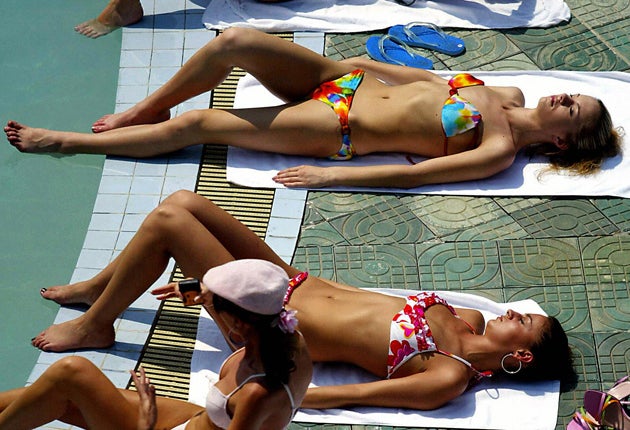Public advice on suntanning may mean vitamin deficiency risk
Health bodies to acknowledge need to tan during peak hours – despite cancer risks

Your support helps us to tell the story
From reproductive rights to climate change to Big Tech, The Independent is on the ground when the story is developing. Whether it's investigating the financials of Elon Musk's pro-Trump PAC or producing our latest documentary, 'The A Word', which shines a light on the American women fighting for reproductive rights, we know how important it is to parse out the facts from the messaging.
At such a critical moment in US history, we need reporters on the ground. Your donation allows us to keep sending journalists to speak to both sides of the story.
The Independent is trusted by Americans across the entire political spectrum. And unlike many other quality news outlets, we choose not to lock Americans out of our reporting and analysis with paywalls. We believe quality journalism should be available to everyone, paid for by those who can afford it.
Your support makes all the difference.Concerns over the link between rising skin cancer rates and exposure to sunshine may have led to overly precautionary advice being given to the public about staying out of the sun at midday, according to a confidential "position statement" by leading health organisations.
The current advice to the public from the leading research charity on skin cancer, Cancer Research UK, states to spend between 11am and 3pm in the shade and to cover the skin with clothing, hats and sunscreen if out. But a confidential position statement being prepared by the charity in collaboration with other health organisations – and seen by The Independent – acknowledges the changing evidence and emphasises the importance of exposing the skin to the midday sun without any protection in order to maximise production of vitamin D.
Many experts are concerned that past advice designed to protect against skin cancer may have resulted in an increased risk of other illnesses linked to a lack of vitamin D, which the body can only produce when skin in exposed to bright sunlight. New concerns about Britain's policy on sun exposure led to this review of the evidence about the risks and benefits of staying in the shade and covering up during the sunniest part of the day.
The confidential document, seen by The Independent, says: "The time required to make sufficient vitamin D is typically short and less than the amount of time needed for skin to redden and burn. Regularly going outside for a matter of minutes around the middle of the day without sunscreen should be enough. When it comes to sun exposure, little and often is best. However, people should get to know their own skin to understand how long they can spend outside before risking sunburn under different conditions."
The wording of the draft document is being seen by come commentators as a tacit admission by Cancer Research UK that it had got it wrong in the past about telling people to avoid the midday sun, to apply sunscreen and to stay in the shade in order to avoid exposure to the cancer-causing rays of the sun.
"Cancer Research UK is working on a new position statement on vitamin D and sunshine which it expects to agree with other health organisations," said Oliver Gillie, a health writer who has championed the case for vitamin D. "Their new position is expected to break with 20 years of advice to seek the shade and is expected to suggest that people go out in the sun in the middle of the day for at least a few minutes. Several health bodies have agreed to the wording but others are still discussing the details."
Organisations such as the British Heart Foundation, the Multiple Sclerosis Society, Diabetes UK and the National Osteoporosis Society are discussing what their public position should be on sunshine and vitamin D in the light of several new studies suggesting a link between various illnesses and a chronic lack of the vitamin.
The draft position statement says: "Cancer Research UK's SunSmart campaign encourages people to enjoy the sun safely and avoid exposures that lead to sunburn. However, for most people, sunlight is also the most important source of vitamin D, which is essential for good bone health.
"It is important to ensure that skin cancer prevention messages are balanced with the need to make enough vitamin D, and reflect the latest scientific evidence." Sara Hiom, director of health information at the charity, said that the draft consensus statement has not yet been finalised, agreed or released. "It is not our advice to the public and should not be interpreted in that way," Ms Hiom said.
"Even once we reach a consensus we will not be advising the public to go in the sun in the middle of the day without sunscreen. This is because, for some people – those most likely to be at risk of skin cancer – a few minutes in the middle of the day is enough for them to burn and cause serious and lasting skin damage.
"The very fact that messages around safe sun exposure times cannot be generalised to the population means that our advice needs to be general and is, and will remain, to enjoy the sun safely, spend time in the shade around midday and know your own skin type."
Join our commenting forum
Join thought-provoking conversations, follow other Independent readers and see their replies
Comments